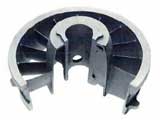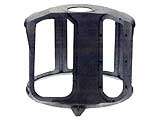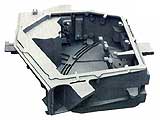Plaster Mold Process



The plaster mold process can be the most cost-effective means to produce cast aluminum parts. Since plaster molds are quickly made from inexpensive master tooling which lasts indefinitely, the process is ideal for prototypes, short run castings, or orders of up to 1,200 castings per year.
Step 1. Blueprints and specifications are analyzed to determine the optimum procedure for design of the pattern and mold. The plaster mold process offers maximum design flexibility and low cost tooling-both pattern and mold may be easily changed before more expensive tooling such as hard metal dies need to be created for higher production runs of thousands of castings per week or month.
Step 2. Supreme Castings & Pattern Corporation’s aircraft quality pattern makers combine foundry craftsmanship with CNC machining and engineering to create a positive model of the part, scaled to allow for metal shrinkage. The experience and judgment of Supreme’s foundry craftsmen determine the optimum planes at which the mold and cores must be split (“parting line”).
Step 3. A negative master tool is created, out of epoxy materials from positive models, although other materials such as metal may be used depending on design criteria, and is usually “customer owned” after first article approval.
Step 4. Mold release is applied to the epoxy negative master with “backing” added where strength is required. A rubber mixture is poured to form a positive reusable mold to be used in the foundry. Because of its flexibility, use of rubber requires little or no draft, resulting in reduction of tooling design costs and maximizing of secondary machining efficiencies.
Step 5. A special mix gypsum plaster slurry is carefully poured over the rubber positive. Fine grain plaster is used because it forms easily, does not shrink, is an excellent insulator and requires no parting or releasing agents which might introduce distortion. The properties inherent in plaster permit thin wall cross sections ranging down to 0.050″, and a level of accuracy, dimensional tolerance and repeatability superior to sand casting and is similar to more costly investment casting or die casting techniques.
Step 6. The plaster negative mold is released from the rubber positive. Areas of high stress concentration, which may create porosity due to uneven cooling of the molten aluminum, are analyzed and metal “chills” added to these areas.
Step 7. The plaster negative mold is oven – cured to drive off moisture. Before molten aluminum is poured, cores, chills, risers and/or gates are introduced to assure a casting of uniform mechanical integrity. It is at this stage in the mold assembly process that Supreme’s expertise provides a technological edge over conventional plaster mold casting firms. The specific technology-“Composite Mold Casting,” is an innovation introduced to plaster molding by Supreme’s metallurgists and engineers. Chief benefits of this technology are directing the solidification sequence, control of porosity, and assurance of fine grain structure resulting in higher mechanical strength and X-ray levels than conventional “plaster only” techniques.
Step 8. Molten aluminum alloy, heated to a critical temperature is carefully poured into the plaster mold and allowed to cool and solidify. The cooling rate is controlled to minimize porosity. The use of fine grain plaster and rubber for the intermediate steps produces a mold surface which can cast fine detail such as engravings, lettering, slots, holes, ribs, etc. Surface finishes to 125 RMS or better are normal.
Step 9. The casting emerges from the mold ready for cleaning and grinding, heat treating, straightening, sand blasting, non destructive testing, and quality control inspection.
